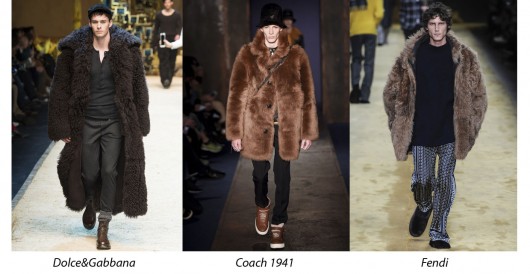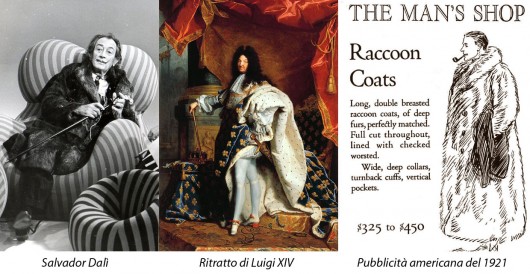OPTIONAL FUR
La pelliccia nel passato
”Il lusso è una necessità che inizia dove termina la necessità”: parole di Mademoiselle Chanel, che possiamo riportare all’argomento che ci proponiamo di considerare qui. Pelliccia al maschile sì o no? In un’epoca libera da imperativi è impossibile formulare un giudizio perentorio. Mettiamo invece in tavola i pro e i contro. Da un lato pelliccia significa da sempre lusso, ricchezza, potere. L’avvicendarsi tra aristocrazia e borghesia ai vertici della scala sociale non ha scalfito il suo prestigio, semmai lo ha riportato a declinazioni più controllate. Tra il manto d’ermellino di Re Sole e il cappotto con collo, polsi e fodera in pelo di un qualsiasi magnate industriale del diciannovesimo/ventesimo secolo la differenza c’è ovviamente. Ma è puramente “quantitativa” e non intacca la valenza di auto-rappresentazione espressa da un indumento così importante.

La pelliccia nella f/w 2016/17
In determinati momenti la pelliccia ha rappresentato anche l’anticonformismo: dei dandy “fin de siècle”, di artisti, creativi e personaggi legati allo show business ma non solo, che hanno fatto da apripista nel processo di rivisitazione dei codici attuali del vestire Uomo. Dall’altro lato i ragionamenti si fanno forse più prosaici. Non sono in discussione né la bellezza né i tanti plus che incorpora la materia pelliccia, bensì la sua necessità. Sarebbe falso affermare che la pelliccia oggi è indispensabile per proteggersi dal freddo. Lasciamo questa impellenza a Fred Flintstone. Le eco-fur ed un’infinità di techno-texture ovviano egregiamente al problema. Detto ciò, liberi tutti. A patto che ciascuno si assuma la responsabilità delle proprie scelte. Giorgio Re
”Luxury is a necessity that starts where the necessity ends”: words by Mademoiselle Chanel, that we can apply to the topic we are going to discuss. Fur for men: yes or no? In an era free from imperative we can’t express a peremptory judgement. But let’s talk about the pros and the cons. On one side fur means since ever luxury, wealth, power. The transition from aristocracy to bourgeoisie at the top of the social scale didn’t affect its prestige, if anything brought it back to more controlled displays. There’s a clear difference between the ermine cape of the Sun King and the coat with collar, cuffs and lining made of fur worn by any magnate in the 19th/20th century. But this difference is purely “quantitative” and doesn’t change the self-representation value expressed by such an important garment. In specific moments the fur has represented unconventionality: dandies, artists, celebrities that has been pioneers of the process of revisiting the menswear’s current canons. On the other side the reasoning becomes more prosaic. We don’t discuss about the beauty and the advantages of the fur, but about its usefulness. Today the fur is not essential for protecting from cold. Leave this urgency to fred Flintstone. Eco-furs and a lot of techno-fabrics solve the problem very well. That said, we’re free to decide. Provided that someone takes on the responsibility of his own choices. Giorgio Re






